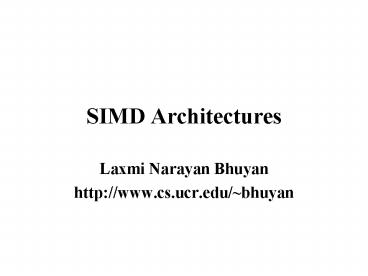SIMD Architectures - PowerPoint PPT Presentation
Title:
SIMD Architectures
Description:
Operations can be performed in parallel on each element of a large regular data ... When computers were large, could amortize the control portion of many replicated ... – PowerPoint PPT presentation
Number of Views:45
Avg rating:3.0/5.0
Title: SIMD Architectures
1
SIMD Architectures
- Laxmi Narayan Bhuyan
- http//www.cs.ucr.edu/bhuyan
2
(No Transcript)
3
(No Transcript)
4
(No Transcript)
5
(No Transcript)
6
(No Transcript)
7
(No Transcript)
8
(No Transcript)
9
(No Transcript)
10
Data Parallel Model
- Operations can be performed in parallel on each
element of a large regular data structure, such
as an array - 1 Control Processsor broadcast to many PEs (see
Ch. 1, Fig. 1-25, page 45 of CSG99) - When computers were large, could amortize the
control portion of many replicated PEs - Condition flag per PE so that can skip
- Data distributed in each memory
- Early 1980s VLSI gt SIMD rebirth 32 1-bit PEs
memory on a chip was the PE - Data parallel programming languages lay out data
to processor
11
Data Parallel Model
- Vector processors have similar ISAs, but no data
placement restriction - SIMD led to Data Parallel Programming languages
- Advancing VLSI led to single chip FPUs and whole
fast µProcs (SIMD less attractive) - SIMD programming model led to Single Program
Multiple Data (SPMD) model - All processors execute identical program
- Data parallel programming languages still useful,
do communication all at once Bulk Synchronous
phases in which all communicate after a global
barrier
12
SIMD Programming High-Performance Fortran (HPF)
- Single Program Multiple Data (SPMD)
- FORALL Construct similar to Fork
- FORALL (I1N), A(I) B(I) C(I), END
FORALL - Data Mapping in HPF
- 1. To reduce interprocessor communication
- 2. Load balancing among processors
- http//www.npac.syr.edu/hpfa/
- http//www.crpc.rice.edu/HPFF/
13
How does an SIMD computer work?
- A Host computer is necessary to do the I/O
operations - The user program is loaded into the control
memory - The data is distributed to all the memory modules
- The control unit decodes the instn and executes
it if it is a scalar instn. If it is a vector
instn, it broadcasts the control signals to the
PEs to do the executions - Before broadcasting the control signals, the CU
broadcasts an enable vector which will enable the
PEs
14
Masking and Data Routing Mechanisms
- A,B,C working registers
- Si status (1 active, 0 inactive)
- Ri Data routing register
- Di holds address
- Ii Index register
15
Example
16
Matrix Multiplication
17
(No Transcript)
18
(No Transcript)
19
N N Mesh
20
The Illiac IV Architecture
- Distributed memory architecture
- 64 PEs connected as an 8X8 2-D mesh with end
around connection
- LDB Local Data Buffer
- 64, 64-bit each
- PEM 2K X 64 bits memory
21
The Illiac IV Network
22
Maspar MP-1 Architecture
- Configuration with 1K-16K PEs are available
- Each PE has a 4-bit ALU, 1-bit logic unit, a
64-bit mantissa unit, a 16-bit exponent unit,
communication input and output ports - Each PE has 40 32-bit registers available to the
programmer - Each processor board has 1024 PEs arranges as 64
PE clusters (PECs) with 16 PEs per cluster - Each PEC is a chip connected to 8 neighbors via
an octagonal mesh - Another network, called Multistage Crossbar
Network, with three router stages gives a
function of 1024X1024 crossbar for routing from
any PEC to another PEC
23
(No Transcript)
24
(No Transcript)































